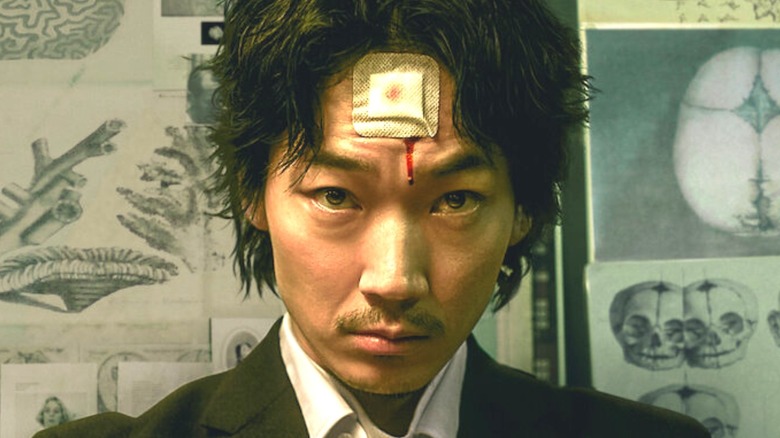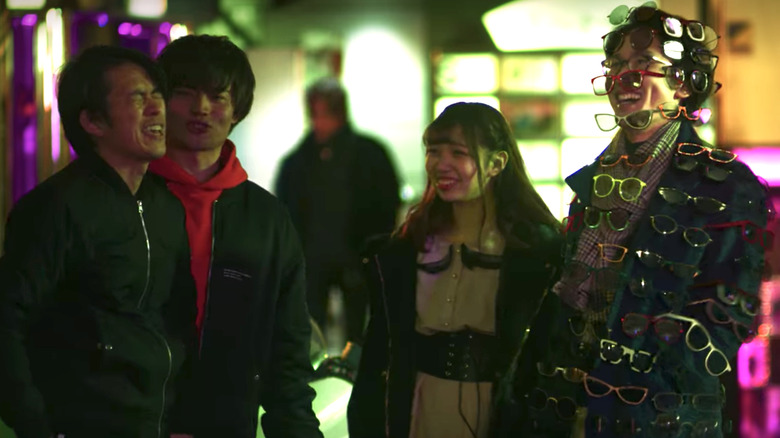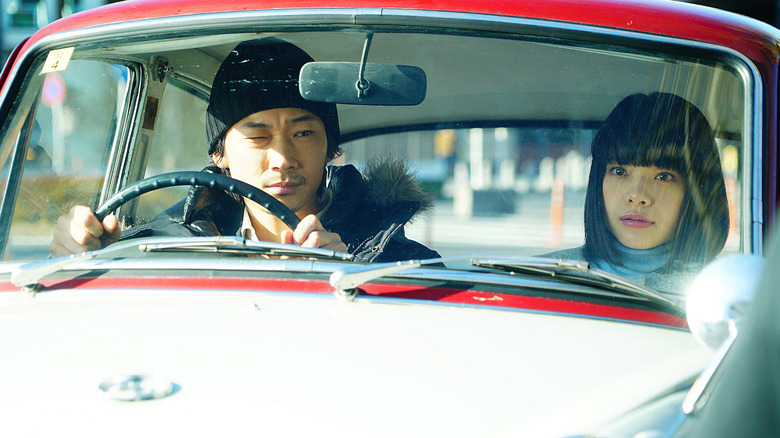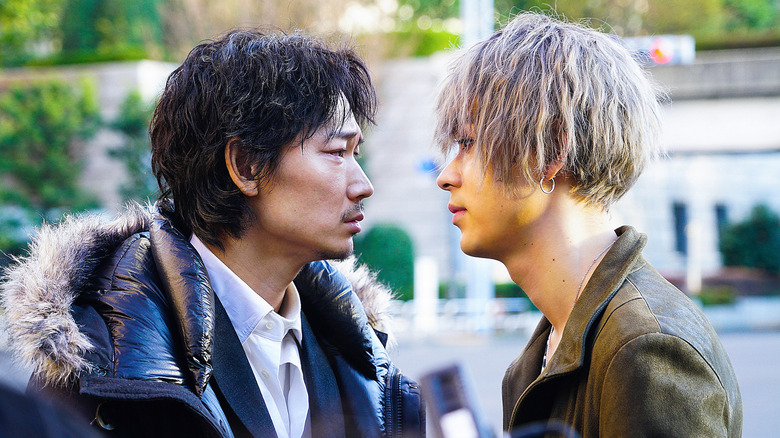The Ending Of Homunculus Explained
Netflix premiered a new Japanese horror film called "Homunculus" on April 22, 2021. Based on the popular manga of the same name, "Homunculus" stars Gô Ayano as Susumu Nakoshi, a 34-year-old amnesiac man who lives in his car. He then meets Manabu Ito, played by Ryô Narita, a strange medical student who asks Nakoshi to participate in an experiment aimed at opening up his third eye, allowing him to see the inner secrets of the people around him.
Out of money and hope, Nakoshi agrees to undergo the trepanation procedure — meaning Ito drills a hole into his head and through his skull — and soon enough he starts seeing everyone's "homunculus" and tries to help them. Meanwhile, Nakoshi keeps encountering this woman who he believes is his former girlfriend, but without his memories to confirm it, Nakoshi is left in the dark.
"Homunculus" is directed by Takashi Shimizu, the director of the Japanese "The Grudge" horror franchise. The original manga that "Homunculus" is based on is written and illustrated by Hideo Yamamoto, and ran from 2003 to 2011. The movie makes a few key changes to the original story, and as it deals with concepts like inner trauma and a sixth sense, "Homunculus" can get a little confusing.
Here's the ending of "Homunculus," explained.
What does homunculus mean?
In the history of science and psychology, homunculus is a term used to refer to "a miniature human inside the brain," as Ito explains in the film. But in this case, the term takes on a broader, stranger meaning. Ito and Nakoshi discuss the visions Nakoshi is seeing, distorted and out-of-this-world images of the people around him, with Ito claiming that these are people's homunculi, manifestations of "a person's source of mental stress" or "the self-images that each individual has of themselves." To Ito, the homunculi that Nakoshi sees are depictions of each person's life-altering trauma. For example, the member of the yakuza who Nakoshi makes cry has trauma relating to the pinky finger and an old experience involving a sickle, which Nakoshi sees reflected in his homunculus.
Trying to figure out the meaning behind everything he's seeing, Nakoshi attempts to help people overcome their trauma and get rid of their homunculus, to varying results. Whenever he does this, Nakoshi also takes an aspect of their homunculus on himself. While at first Nakoshi doesn't think Ito has a homunculus, he finally realizes the truth in the final act of the film, forcing Ito to face his past issues relating to his father. In the aftermath, Ito performs trepanation on himself and sews his right eye shut so that he can finally see homunculi as well, though he loses his sanity in the process. "Homunculus" seems to portray the homunculi that Nakoshi sees as real and not just figments of his imagination, and both Nakoshi and Ito believe that as well. Despite that, another interpretation of the film could conclude that all of it is a consequence of the characters' insanity and inability to face their own trauma.
Nakoshi remembers his past
In the second half of "Homunculus," Nakoshi follows a woman who he believes is his former girlfriend, Nanako, from before he lost his memory. He opens up to her and shares his wish to get back together, but in the morning, his inner eye reveals the truth about who she is and what happened to the real Nanako. The film only shows a small glimpse of what her homunculus looks like, but it's enough for Nakoshi to realize that she is not his old girlfriend. In reality, she is actually the woman who killed Nanako in a car accident, the event that also caused his amnesia. Although she wasn't driving and really didn't cause the accident, it's clear that the event left a huge mark on her.
Finally breaking through his dream of what could've been, Nakoshi goes further back into his memories, realizing what he was really trying so hard not to remember. In flashbacks it's revealed that right before the accident Nanako suffers a miscarriage. The couple gets into a horrible fight, with Nanako calling Nakoshi "empty," saying "I bet you wouldn't cry even if I died." Nanako runs out of the house, and a while later Nakoshi tries to catch up and talk it through. The two fight again and Nanako runs away from Nakoshi, right into the path of an oncoming car. Realizing all of this, Nakoshi must finally face his own guilt and involvement in the accident, and he lets the woman go. Now a drastically changed man, Nakoshi gives up on Ito's experiment and the third eye and attempts to leave it all behind to move on, something Ito seems unable to do.
The original manga vs. the movie
Fans of the original "Homunculus" manga are a bit underwhelmed by the live-action film adaptation, as it changes a lot of key points of the story. For starters, the movie alters the theme, portraying the idea that everything Nakoshi sees is real, and whatever he does to help others get rid of their homunculi is justified. Considering some of Nakoshi's questionable actions in the film, this is a little troubling. In the manga, Nakoshi is a self-centered misanthrope whose sanity is questioned all the way to the end, and it's very obvious that Nakoshi is not a good person. Even in the final chapters of the manga, it's unclear whether or not what Nakoshi sees are real or simply images created by his brain as he succumbs to insanity. The manga also doesn't include any loss of memory or Nanako dying storyline, as Nanako is alive and well throughout the manga, at least until Nakoshi forces her to undergo trepanation.
The other biggest change from the "Homunculus" manga to the movie is the characterization of Ito. At the end of the film, Ito goes crazy, drilling a hole in his own head and sewing his right eye shut in an attempt to be like Nakoshi. In the original manga, it's actually Nakoshi who loses his mind and stitches his eye shut to always see the homunculi, while Ito goes through their own personal journey of self-discovery and gender identity. For Ito, the manga heavily implies that the character is actually transgender, with a lot of their personal trauma stemming from being unable to express themself in their youth. In the final chapter, Ito is finally able to accept themself and be who they really are, without the trauma of their father holding them back. In an unfortunate change from the original manga, the film completely erases this aspect of the character.



